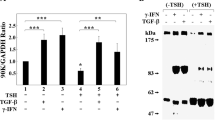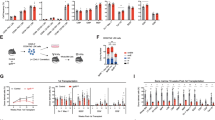Abstract
The restriction of immunoglobulin (Ig) expression to B lymphocytes is well established. However, several reports have confirmed that the Ig gene can be expressed in many non-B cancer cells and/or some normal cells. Our aim is to determine whether the Ig gene promoter can be activated in non-B cancer cells and to identify the regulatory mechanism for Ig gene expression. Our results show that the Ig promoter of VH4-59 was activated in several non-B cancer cell lines. Moreover, two novel positive regulatory elements, an enhancer-like element at −800 to −610 bp and a copromoter-like element at −610 to −300 bp, were identified in two epithelial cancer cell lines, HeLa S3 and HT-29. The octamer element (5′-ATGCAAAT-3′) located in the Ig promoter, a crucial element for B-cell-derived Ig gene transcription, was also very important for non-B-cell-derived Ig gene transcription. More importantly, we confirmed that octamer-related protein-1 (Oct-1), but not Oct-2, was a crucial transcriptional factor for Ig gene transcription due to its ability to bind to the octamer element of the Ig promoter in epithelial cancer cells. These results suggested the presence of a distinct regulatory mechanism for Ig gene expression in non-B cancer cells.
This is a preview of subscription content, access via your institution
Access options
Subscribe to this journal
Receive 12 digital issues and online access to articles
$119.00 per year
only $9.92 per issue
Buy this article
- Purchase on Springer Link
- Instant access to full article PDF
Prices may be subject to local taxes which are calculated during checkout






Similar content being viewed by others
References
Henderson A, Calame K . Transcriptional regulation during B cell development. Annu Rev Immunol 1998; 16: 163–200.
Qiu XY, Yang GZ . Study on the characteristics of Ig-like protein from malignant tumor cytoplasm and analysis of Ig gene structure. Chin J Immunol 1996; 5: 296.
Qiu XY, Yang GZ . Ig-like protein present in epithelial malignant tumor cells. J Norman Bethune Univ Med Sci 1996; 6: 572–575.
Wang DS, Qiu XY, Zhu XH, Lv P, Jiang N, Lv P et al. Purification and Western-blot analysis of Ig-like protein. J Beijing Med Univ 2000; 32: 310–312.
Qiu X, Zhu X, Zhang L, Mao Y, Zhang J, Hao P et al. Human epithelial cancers secrete immunoglobulin g with unidentified specificity to promote growth and survival of tumor cells. Cancer Res 2003; 63: 6488–6495.
Huang J, Sun X, Mao Y, Zhu X, Zhang P, Zhang L et al. Expression of immunoglobulin gene with classical V-(D)-J rearrangement in mouse brain neurons. Int J Biochem Cell Biol 2008; 40: 1604–1615.
Zhu X, Li C, Sun X, Mao Y, Li G, Liu X et al. Immunoglobulin mRNA and protein expression in human oral epithelial tumor cells. Appl Immunohistochem Mol Morphol 2008; 16: 232–238.
Huang J, Zhang L, Ma T, Zhang P, Qiu X . Expression of immunoglobulin gene with classical V-(D)-J rearrangement in mouse testis and epididymis. J Histochem Cytochem 2009; 57: 339–349.
Zheng J, Huang J, Mao Y, Liu S, Sun X, Zhu X et al. Immunoglobulin gene transcripts have distinct VHDJH recombination characteristics in human epithelial cancer cells. J Biol Chem 2009; 284: 13610–13619.
Kimoto Y . Expression of heavy-chain constant region of immunoglobulin and T-cell receptor gene transcripts in human non-hematopoietic tumor cell lines. Genes Chromosomes Cancer 1998; 22: 83–86.
Li M, Feng DY, Ren W, Zheng L, Zheng H, Tang M et al. Expression of immunoglobulin kappa light chain constant region in abnormal human cervical epithelial cells. Int J Biochem Cell Biol 2004; 36: 2250–2257.
Babbage G, Ottensmeier CH, Blaydes J, Stevenson FK, Sahota SS . Immunoglobulin heavy chain locus events and expression of activation-induced cytidine deaminase in epithelial breast cancer cell lines. Cancer Res 2006; 66: 3996–4000.
Chen Z, Gu J . Immunoglobulin G expression in carcinomas and cancer cell lines. FASEB J 2007; 21: 2931–2938.
Liu HD, Zheng H, Li M, Hu DS, Tang M, Cao Y . Upregulated expression of kappa light chain by Epstein–Barr virus encoded latent membrane protein 1 in nasopharyngeal carcinoma cells via NF-kappaB and AP-1 pathways. Cell Signal 2007; 19: 419–427.
Zheng H, Li M, Ren W, Zeng L, Liu HD, Hu D et al. Expression and secretion of immunoglobulin alpha heavy chain with diverse VDJ recombinations by human epithelial cancer cells. Mol Immunol 2007; 44: 2221–2227.
Lee G, Laflamme E, Chien CH, Ting HH . Molecular identity of a pan cancer marker, CA215. Cancer Biol Ther 2008; 7: 2007–2014.
Lee G . Cancer cell-expressed immunoglobulins: CA215 as a pan cancer marker and its diagnostic applications. Cancer Biomark 2009; 5: 137–142.
Lin H, Grosschedl R . Failure of B-cell differentiation in mice lacking the transcription factor EBF. Nature 1995; 376: 263–267.
Quong MW, Martensson A, Langerak AW, Rivera RR, Nemazee D, Murre C . Receptor editing and marginal zone B cell development are regulated by the helix–loop–helix protein, E2A. J Exp Med 2004; 199: 1101–1112.
Yabuki M, Ordinario EC, Cummings WJ, Fujii MM, Maizels N . E2A acts in cis in G1 phase of cell cycle to promote Ig gene diversification. J Immunol 2009; 182: 408–415.
Pawlitzky I, Angeles CV, Siegel AM, Stanton ML, Riblet R, Brodeur PH . Identification of a candidate regulatory element within the 5′ flanking region of the mouse Igh locus defined by pro-B cell-specific hypersensitivity associated with binding of PU.1, Pax5, and E2A. J Immunol 2006; 176: 6839–6851.
Nakayama M, Suzuki H, Yamamoto-Nagamatsu N, Barman HK, Kikuchi H, Takami Y et al. HDAC2 controls IgM H- and L-chain gene expressions via EBF1, Pax5, Ikaros, Aiolos and E2A gene expressions. Genes Cells 2007; 12: 359–373.
Kim U, Qin XF, Gong S, Stevens S, Luo Y, Nussenzweig M et al. The B-cell-specific transcription coactivator OCA-B/OBF-1/Bob-1 is essential for normal production of immunoglobulin isotypes. Nature 1996; 383: 542–547.
Schubart K, Massa S, Schubart D, Corcoran LM, Rolink AG, Matthias P . B cell development and immunoglobulin gene transcription in the absence of Oct-2 and OBF-1. Nat Immunol 2001; 2: 69–74.
Ju Z, Volpi SA, Hassan R, Martinez N, Giannini SL, Gold T et al. Evidence for physical interaction between the immunoglobulin heavy chain variable region and the 3′ regulatory region. J Biol Chem 2007; 282: 35169–35178.
Laumen H, Nielsen PJ, Wirth T . The BOB.1/OBF.1 co-activator is essential for octamer-dependent transcription in B cells. Eur J Immunol 2000; 30: 458–469.
Poellinger L, Yoza BK, Roeder RG . Functional cooperativity between protein molecules bound at two distinct sequence elements of the immunoglobulin heavy-chain promoter. Nature 1989; 337: 573–576.
Kunkel GR, Pederson T . Upstream elements required for efficient transcription of a human U6 RNA gene resemble those of U1 and U2 genes even though a different polymerase is used. Genes Dev 1988; 2: 196–204.
Nakajima N, Horikoshi M, Roeder RG . Factors involved in specific transcription by mammalian RNA polymerase II: purification, genetic specificity, and TATA box-promoter interactions of TFIID. Mol Cell Biol 1988; 8: 4028–4040.
Yang J, Muller-Immergluck MM, Seipel K, Janson L, Westin G, Schaffner W et al. Both Oct-1 and Oct-2A contain domains which can activate the ubiquitously expressed U2 snRNA genes. EMBO J 1991; 10: 2291–2296.
Hinkley C, Perry M . Histone H2B gene transcription during Xenopus early development requires functional cooperation between proteins bound to the CCAAT and octamer motifs. Mol Cell Biol 1992; 12: 4400–4411.
Sun Z, Kitchingman GR . Bidirectional transcription from the human immunoglobulin VH6 gene promoter. Nucleic Acids Res 1994; 22: 861–868.
Gstaiger M, Georgiev O, van Leeuwen H, van der Vliet P, Schaffner W . The B cell coactivator Bob1 shows DNA sequence-dependent complex formation with Oct-1/Oct-2 factors, leading to differential promoter activation. EMBO J 1996; 15: 2781–2790.
Massa S, Junker S, Schubart K, Matthias G, Matthias P . The OBF-1 gene locus confers B cell-specific transcription by restricting the ubiquitous activity of its promoter. Eur J Immunol 2003; 33: 2864–2874.
Bartholdy B, Du Roure C, Bordon A, Emslie D, Corcoran LM, Matthias P . The Ets factor Spi-B is a direct critical target of the coactivator OBF-1. Proc Natl Acad Sci USA 2006; 103: 11665–11670.
Corcoran LM, Karvelas M, Nossal GJ, Ye ZS, Jacks T, Baltimore D . Oct-2, although not required for early B-cell development, is critical for later B-cell maturation and for postnatal survival. Genes Dev 1993; 7: 570–582.
Corcoran LM, Hasbold J, Dietrich W, Hawkins E, Kallies A, Nutt SL et al. Differential requirement for OBF-1 during antibody-secreting cell differentiation. J Exp Med 2005; 201: 1385–1396.
Tanaka M, Herr W . Differential transcriptional activation by Oct-1 and Oct-2: interdependent activation domains induce Oct-2 phosphorylation. Cell 1990; 60: 375–386.
Delacroix L, Begon D, Chatel G, Jackers P, Winkler R . Distal ERBB2 promoter fragment displays specific transcriptional and nuclear binding activities in ERBB2 overexpressing breast cancer cells. DNA Cell Biol 2005; 24: 582–594.
Acknowledgements
This work was supported by Fundamental Research Grants 30572094 and 30772470 from the Natural Sciences Foundation, China. We thank Dr Dalong Ma and Dr Mingxu Xu (Peking University Center for Human Disease Genomics) for their comments and suggestions. This manuscript was proofread by an English-speaking professional with a science background at Elixigen Corporation.
Author information
Authors and Affiliations
Rights and permissions
About this article
Cite this article
Zhu, X., Wu, L., Zhang, L. et al. Distinct regulatory mechanism of immunoglobulin gene transcription in epithelial cancer cells. Cell Mol Immunol 7, 279–286 (2010). https://doi.org/10.1038/cmi.2010.13
Received:
Revised:
Accepted:
Published:
Issue Date:
DOI: https://doi.org/10.1038/cmi.2010.13
Keywords
This article is cited by
-
Functional analysis of tumor-derived immunoglobulin lambda and its interacting proteins in cervical cancer
BMC Cancer (2023)
-
Current insights into the expression and functions of tumor-derived immunoglobulins
Cell Death Discovery (2021)
-
Cancer-derived sialylated IgG promotes tumor immune escape by binding to Siglecs on effector T cells
Cellular & Molecular Immunology (2020)
-
Cancer cell-derived immunoglobulin G activates platelets by binding to platelet FcγRIIa
Cell Death & Disease (2019)
-
AID expression increased by TNF-α is associated with class switch recombination of Igα gene in cancers
Cellular & Molecular Immunology (2016)



